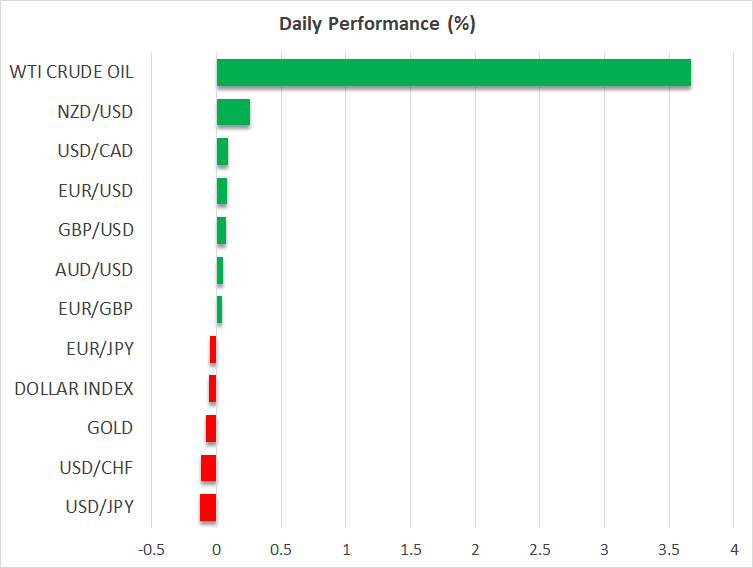- Biden’s tax increases dampen Treasury yields, dollar slips back
- S&P 500 hits new record above 4,000 amid recovery hopes, NFP eyed
- Oil likes OPEC+ plans to gradually ease supply curbs

Dollar on the backfoot ahead of NFP
The US dollar was struggling to hold onto to its weekly gains after falling sharply on Thursday on the back of the slide in Treasury yields. The retreat in long-dated yields comes after President Biden said his $2 trillion infrastructure plan would be paid for entirely by increases in corporate taxes, alleviating fears that the massive spending would stoke inflation and overburden the US economy with debt.
The 10-year yield had dropped to 1.67% on Friday, though the dollar was attempting to move off its lows and its index against a basket of currencies was almost flat after the Asian close. The greenback could get a chance to bounce back later in the session if the March nonfarm payrolls report (due at 13:30 GMT) smashes expectations amid some predictions of a bumper month for America’s labour market. Otherwise, the dollar is on track to finish the week with only marginal gains.
Optimism lifts S&P 500 to new all-time high
Although the scope of Biden’s proposed tax hikes was far greater than what many investors were anticipating, the infrastructure plan should nevertheless provide a substantial boost to the United States’ long-term economic prospects. This could be one explanation as to why equity traders appear to have taken the planned increase in the corporate income tax rate from 21% to 28% in their stride. But a more likely reason is that markets think it will be difficult for the Democrats to push ahead with big tax hikes given the scale of opposition by the Republicans as well as many business groups.
In the meantime, yesterday’s upbeat manufacturing data has added to the optimism about the recovery, while softer-than-expected weekly jobless claims have eased fears about an overheating economy that would prompt the Fed to start tapering early. The ISM manufacturing PMI hit a 37-year high in March even as initial jobless claims unexpectedly rose in the week ending March 27.
Stocks revelled in the optimism, with the S&P 500 soaring to record highs to close above the 4,000 level for the first ever. The Nasdaq Composite also rallied, closing 1.8% higher. But the Dow Jones was up just 0.5% amid signs of some unwinding of the recent rotation out of tech and into value and cyclical stocks.
Oil surges, but all calm in FX sphere
With stock markets across Europe and North America closed today for Good Friday, FX markets were in a calm mood. The Australian dollar was steadier after yesterday’s powerful rebound from 3-month lows. The euro and pound also benefited from the dollar’s pullback but were flat today and only the kiwi managed to extend its gains.
In commodities, gold lost some steam after two days of strong gains when it rallied back above the $1,700/oz level. But oil posted a surprise reversal on Thursday, jumping by more than 3%, after OPEC and its allies announced a gradual lifting of output quotas. OPEC+ producers decided to keep April output at March levels but raise it by 350,000 bpd in May and June, and by a further 450,000 bpd in July.
Although the production boost was not expected to be agreed at the April meeting, especially as Europe is facing a prolonged period of national lockdowns, the announcement seems to have brought some certainty to the supply outlook even though the demand picture remains clouded. But judging by the reaction in oil markets, investors are betting that demand will recover strongly in the second half of the year and more than offset the planned increases in supply.

